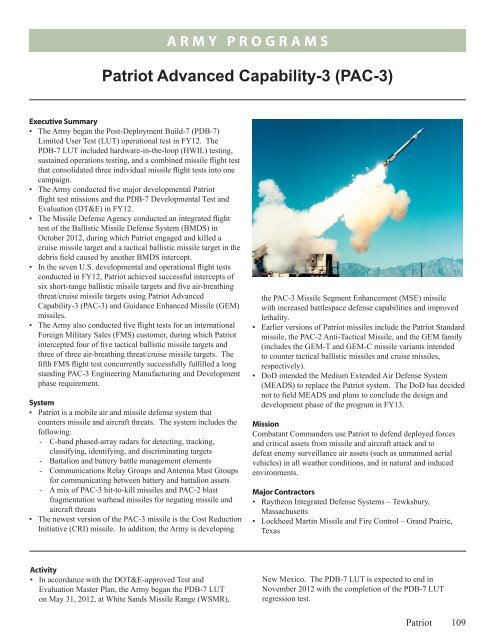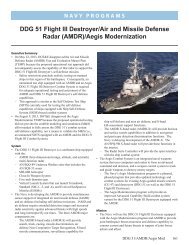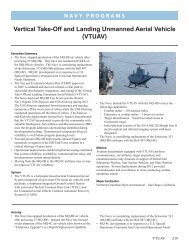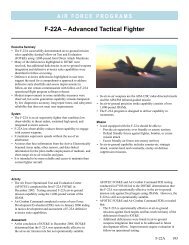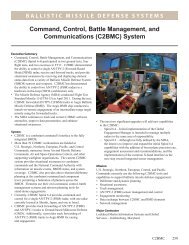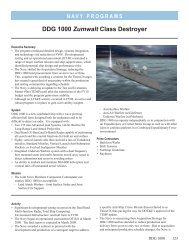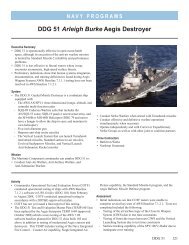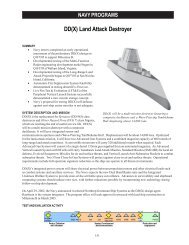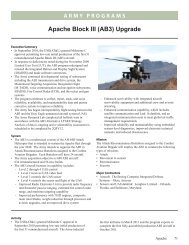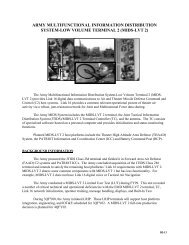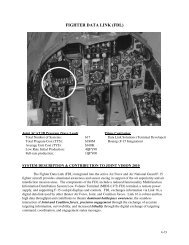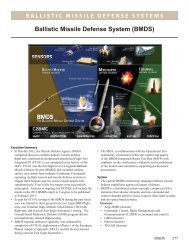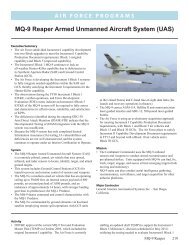Patriot Advanced Capability-3 (PAC-3) - DOT&E
Patriot Advanced Capability-3 (PAC-3) - DOT&E
Patriot Advanced Capability-3 (PAC-3) - DOT&E
Create successful ePaper yourself
Turn your PDF publications into a flip-book with our unique Google optimized e-Paper software.
ARMY PROGRAMS<br />
<strong>Patriot</strong> <strong>Advanced</strong> <strong>Capability</strong>-3 (<strong>PAC</strong>-3)<br />
executive summary<br />
• The Army began the Post-Deployment Build-7 (PDB-7)<br />
Limited User Test (LUT) operational test in FY12. The<br />
PDB-7 LUT included hardware-in-the-loop (HWIL) testing,<br />
sustained operations testing, and a combined missile flight test<br />
that consolidated three individual missile flight tests into one<br />
campaign.<br />
• The Army conducted five major developmental <strong>Patriot</strong><br />
flight test missions and the PDB-7 Developmental Test and<br />
Evaluation (DT&E) in FY12.<br />
• The Missile Defense Agency conducted an integrated flight<br />
test of the Ballistic Missile Defense System (BMDS) in<br />
October 2012, during which <strong>Patriot</strong> engaged and killed a<br />
cruise missile target and a tactical ballistic missile target in the<br />
debris field caused by another BMDS intercept.<br />
• In the seven U.S. developmental and operational flight tests<br />
conducted in FY12, <strong>Patriot</strong> achieved successful intercepts of<br />
six short-range ballistic missile targets and five air-breathing<br />
threat/cruise missile targets using <strong>Patriot</strong> <strong>Advanced</strong><br />
<strong>Capability</strong>-3 (<strong>PAC</strong>-3) and Guidance Enhanced Missile (GEM)<br />
missiles.<br />
• The Army also conducted five flight tests for an international<br />
Foreign Military Sales (FMS) customer, during which <strong>Patriot</strong><br />
intercepted four of five tactical ballistic missile targets and<br />
three of three air-breathing threat/cruise missile targets. The<br />
fifth FMS flight test concurrently successfully fulfilled a long<br />
standing <strong>PAC</strong>-3 Engineering Manufacturing and Development<br />
phase requirement.<br />
system<br />
• <strong>Patriot</strong> is a mobile air and missile defense system that<br />
counters missile and aircraft threats. The system includes the<br />
following:<br />
- C-band phased-array radars for detecting, tracking,<br />
classifying, identifying, and discriminating targets<br />
- Battalion and battery battle management elements<br />
- Communications Relay Groups and Antenna Mast Groups<br />
for communicating between battery and battalion assets<br />
- A mix of <strong>PAC</strong>-3 hit-to-kill missiles and <strong>PAC</strong>-2 blast<br />
fragmentation warhead missiles for negating missile and<br />
aircraft threats<br />
• The newest version of the <strong>PAC</strong>-3 missile is the Cost Reduction<br />
Initiative (CRI) missile. In addition, the Army is developing<br />
Activity<br />
• In accordance with the DOT&E-approved Test and<br />
Evaluation Master Plan, the Army began the PDB-7 LUT<br />
on May 31, 2012, at White Sands Missile Range (WSMR),<br />
the <strong>PAC</strong>-3 Missile Segment Enhancement (MSE) missile<br />
with increased battlespace defense capabilities and improved<br />
lethality.<br />
• Earlier versions of <strong>Patriot</strong> missiles include the <strong>Patriot</strong> Standard<br />
missile, the <strong>PAC</strong>-2 Anti-Tactical Missile, and the GEM family<br />
(includes the GEM-T and GEM-C missile variants intended<br />
to counter tactical ballistic missiles and cruise missiles,<br />
respectively).<br />
• DoD intended the Medium Extended Air Defense System<br />
(MEADS) to replace the <strong>Patriot</strong> system. The DoD has decided<br />
not to field MEADS and plans to conclude the design and<br />
development phase of the program in FY13.<br />
mission<br />
Combatant Commanders use <strong>Patriot</strong> to defend deployed forces<br />
and critical assets from missile and aircraft attack and to<br />
defeat enemy surveillance air assets (such as unmanned aerial<br />
vehicles) in all weather conditions, and in natural and induced<br />
environments.<br />
major contractors<br />
• Raytheon Integrated Defense Systems – Tewksbury,<br />
Massachusetts<br />
• Lockheed Martin Missile and Fire Control – Grand Prairie,<br />
Texas<br />
New Mexico. The PDB-7 LUT is expected to end in<br />
November 2012 with the completion of the PDB-7 LUT<br />
regression test.<br />
<strong>Patriot</strong> 109
• The Army conducted the PDB-7 LUT operational missile flight<br />
test (P7L-1/2/3) at WSMR in August 2012. During this test,<br />
<strong>Patriot</strong>:<br />
- Engaged and intercepted one tactical ballistic missile target<br />
with a ripple launch (firing of missiles in quick succession)<br />
of GEM-T/<strong>PAC</strong>-3 CRI missiles.<br />
- Engaged a second tactical ballistic missile target with<br />
a ripple launch of two <strong>PAC</strong>-3 missiles. This second<br />
tactical ballistic missile target self-destructed before the<br />
interceptors reached it; therefore, the endgame segment<br />
of the second tactical ballistic missile engagement was<br />
deemed a “No Test.”<br />
- Engaged and intercepted a cruise missile target with a<br />
GEM-T missile in the debris field resulting from the<br />
destruction of the two tactical ballistic missile targets.<br />
• The Army conducted the PDB-7 DT&E at WSMR from<br />
July 2011 to March 2012.<br />
- During PDB-7 flight test P7-4 in November 2011, <strong>Patriot</strong><br />
engaged a short-range ballistic missile target with a ripple<br />
launch of two <strong>PAC</strong>-3 CRI missiles. The first <strong>PAC</strong>-3<br />
missile intercepted the target.<br />
- During PDB-7 flight test P7-3 in November 2011, <strong>Patriot</strong><br />
engaged a short-range ballistic missile target with a ripple<br />
launch of two GEM-T missiles. The first GEM-T missile<br />
intercepted the target.<br />
- During PDB-7 flight test P7-2 in November 2011, <strong>Patriot</strong><br />
engaged two short-range ballistic missile targets with two<br />
ripple launches of GEM-T/GEM-C missiles. The first<br />
GEM-T missile of each ripple engagement intercepted its<br />
target.<br />
- During PDB-7 flight test P7-1 in March 2012, <strong>Patriot</strong> fired<br />
a GEM-T missile at one cruise missile target and a GEM-C<br />
missile at a second cruise missile target. Both <strong>Patriot</strong><br />
missiles intercepted their targets.<br />
• During the first Integrated Fire Control flight test (IFC-1) at<br />
the Utah Test and Training Range in April 2012, <strong>Patriot</strong> fired a<br />
<strong>PAC</strong>-3 CRI missile at a cruise missile target using a Joint Land<br />
Attack Cruise Missile Defense Elevated Netted Sensor System<br />
cue. The <strong>PAC</strong>-3 missile intercepted the target.<br />
• During the first MEADS flight test, the Launcher/Missile<br />
Characterization Test at WSMR in November 2011, MEADS<br />
fired an MSE missile at a simulated target.<br />
• During the FMS G-2 missile flight test at WSMR in<br />
March 2012, <strong>Patriot</strong> intercepted a cruise missile target with a<br />
GEM-T missile.<br />
• During the FMS P-1/P-2 missile flight test at WSMR in<br />
March 2012, <strong>Patriot</strong> engaged a short-range ballistic missile<br />
target with a ripple launch of two <strong>PAC</strong>-3 missiles. The first<br />
<strong>PAC</strong>-3 missile intercepted the target.<br />
• During the FMS G-3/G-6/G-7 missile flight test at WSMR in<br />
May 2012, <strong>Patriot</strong> failed to intercept a short-range ballistic<br />
missile target during the G-3 portion of the mission because of<br />
a missile launch sequence failure. As a result, the G-3 portion<br />
of the mission was repeated using a backup short-range<br />
ballistic missile target, which <strong>Patriot</strong> intercepted using a<br />
GEM-T missile. This was followed by the launch of another<br />
110 <strong>Patriot</strong><br />
Army PrOGrAmS<br />
short-range ballistic missile target, which <strong>Patriot</strong> engaged<br />
using a ripple launch of two GEM-T missiles. The first<br />
GEM-T missile intercepted the target.<br />
• During the FMS G-4/G-5 missile flight test at Eglin AFB,<br />
Florida, in June 2012, <strong>Patriot</strong> performed near-simultaneous<br />
intercepts over water of two air-breathing targets using GEM-T<br />
missiles.<br />
• During the FMS P-3/P-4 missile flight test at WSMR in<br />
September 2012, <strong>Patriot</strong> engaged a short-range ballistic<br />
missile target with a ripple launch of two <strong>PAC</strong>-3 CRI missiles.<br />
The first <strong>PAC</strong>-3 missile intercepted the target. This mission<br />
concurrently fulfilled a long standing <strong>PAC</strong>-3 Engineering<br />
Manufacturing and Development phase requirement.<br />
• During Flight Test Integrated-01 (FTI-01) in October 2012 at<br />
the Reagan Test Site, <strong>Patriot</strong> performed a near-simultaneous<br />
engagement of a short-range ballistic missile target with two<br />
<strong>PAC</strong>-3 interceptors and a cruise missile target with another<br />
<strong>PAC</strong>-3 interceptor. FTI-01 was the first integrated flight test<br />
with multiple firing elements (Aegis Ballistic Missile Defense<br />
[BMD], Terminal High-Altitude Area Defense [THAAD], and<br />
<strong>Patriot</strong>) engaging multiple ballistic missile and air-breathing<br />
targets in a realistic BMDS-level architecture. <strong>Patriot</strong><br />
successfully intercepted both of its targets.<br />
Assessment<br />
• The HWIL phase of the PDB-7 LUT was to have included<br />
equal numbers of runs with and without simulated MSE<br />
missiles. All planned runs without MSE missiles were<br />
completed, but <strong>Patriot</strong> system availability problems led to only<br />
20 percent of the MSE runs being accomplished. As a result,<br />
the effectiveness assessment of the <strong>Patriot</strong> PDB-7 system<br />
with MSE missiles will be limited until the Army conducts a<br />
dedicated HWIL test with simulated MSE missiles. Additional<br />
HWIL testing with MSE missiles is planned as part of PDB-7<br />
regression testing scheduled to complete in November 2012.<br />
• Data analysis is ongoing, but preliminary results indicate<br />
that <strong>Patriot</strong> training remains inadequate to prepare operators<br />
for complex <strong>Patriot</strong> engagements. This was true during<br />
the PDB-6.5 and PDB-6 LUTs as well. This problem<br />
was exacerbated in the PDB-7 LUT because many of<br />
the experienced <strong>Patriot</strong> operators in the test unit were<br />
understandably transferred to deploying units prior to the LUT,<br />
resulting in many inexperienced users and a high variability in<br />
Soldier proficiency across the test unit.<br />
• Calculation of <strong>Patriot</strong> system reliability such as Mean Time<br />
Between Critical Mission Failure using field data is being<br />
investigated. Critical field data including total operating hours<br />
and numbers of critical mission failures for each <strong>Patriot</strong> battery<br />
major end item may not be accurate.<br />
• During the PDB-7 LUT operational missile flight test<br />
(P7L-1/2/3), <strong>Patriot</strong> demonstrated the capability to search,<br />
detect, track, engage, and intercept both a tactical ballistic<br />
missile target and a cruise missile target with GEM-T missiles.<br />
<strong>Patriot</strong> intercepted the cruise missile target in the debris field<br />
caused by the intercept of the first tactical ballistic missile<br />
target and the self-destruction of the second tactical ballistic
missile target. However, the following problems were<br />
observed during this test:<br />
- <strong>Patriot</strong> was to have engaged the first tactical ballistic<br />
missile target with two GEM-T missiles, but the launcher<br />
incorrectly reported a missile count of zero after the first<br />
GEM-T missile launched so a <strong>PAC</strong>-3 missile was launched<br />
instead.<br />
- <strong>Patriot</strong> engaged the second tactical ballistic missile target<br />
with two <strong>PAC</strong>-3 missiles, but the target broke up before the<br />
missiles reached it. The cause of this target failure is under<br />
investigation.<br />
- <strong>Patriot</strong> was to have had two GEM-T missiles available<br />
to engage the cruise missile target, but one could not be<br />
armed. The backup missile was not needed however, as the<br />
first GEM-T missile launched successfully and intercepted<br />
the target.<br />
- Although the <strong>Patriot</strong> crews were not supposed to be<br />
notified when the targets were launched, a test conduct<br />
error led to them hearing the range communications<br />
network during the launches. It is unknown what effect, if<br />
any, this had on the test.<br />
• The <strong>Patriot</strong> system met most of the test objectives during the<br />
PDB-7 DT&E. However, there were some incidents during<br />
the ground testing portion when <strong>Patriot</strong> did not properly<br />
transmit messages, had degraded track triangulation between<br />
batteries, was unable to isolate faults and had to be rebooted,<br />
selected a launcher with no available missiles, and selected<br />
less preferred missiles against threats (e.g., a GEM against a<br />
long-range tactical ballistic missile or a <strong>PAC</strong>-3 missile against<br />
a threat aircraft). The <strong>Patriot</strong> system did not meet its reliability<br />
requirements during this test.<br />
• During PDB-7 flight test P7-4, <strong>Patriot</strong> demonstrated the<br />
capability to search, detect, track, engage, and intercept a<br />
tactical ballistic missile target with <strong>PAC</strong>-3 missiles in a ripple<br />
engagement. There were some discrepancies between the<br />
performance of the second <strong>PAC</strong>-3 missile during its initial turn<br />
and pre-flight simulations. The causes of these discrepancies<br />
are still under investigation. One of the two non-firing <strong>Patriot</strong><br />
batteries did not collect data during the P7-4 flight test. The<br />
affected non-firing battery restarted the data collection system<br />
multiple times in an effort to fix the problem, but it was not<br />
resolved before the engagement.<br />
• During PDB-7 flight test P7-3, <strong>Patriot</strong> demonstrated the<br />
capability to search, detect, track, engage, and intercept a<br />
tactical ballistic missile target with GEM missiles in a ripple<br />
engagement.<br />
• During PDB-7 flight test P7-2, <strong>Patriot</strong> demonstrated the<br />
capability to detect, engage, and intercept short-range ballistic<br />
missile targets with GEM-T missiles. <strong>Patriot</strong> conducted the<br />
second engagement in the presence of the debris cloud caused<br />
by the first intercept.<br />
• During PDB-7 flight test P7-1, <strong>Patriot</strong> demonstrated the<br />
capability to detect, engage, and intercept cruise missile targets<br />
in clutter with GEM-T and GEM-C missiles.<br />
• During IFC-1, <strong>Patriot</strong> demonstrated the capability to use the<br />
Joint Land Attack Cruise Missile Defense Elevated Netted<br />
Army PrOGrAmS<br />
Sensor System cuing data to engage a cruise missile with a<br />
<strong>PAC</strong>-3 missile. The <strong>PAC</strong>-3 missile intercepted the target.<br />
• During the Launcher/Missile Characterization Test, an MSE<br />
missile was launched at a 70-degree angle, performed an<br />
out-of-plane maneuver, and followed the predicted flight path<br />
to the simulated target, which was 120 degrees off the launch<br />
axis. All test objectives were met.<br />
• <strong>Patriot</strong> intercepted four of five tactical ballistic missile targets<br />
and three of three air-breathing threat/cruise missile targets<br />
during five FMS flight tests.<br />
- The original target in the FMS G-3 missile flight test was to<br />
be engaged with only one GEM-T missile, but the GEM-T<br />
missile had a launch sequence failure and there was not<br />
an active back-up missile that could launch in its place.<br />
After this failure, a back-up tactical ballistic missile target<br />
and back-up GEM-T missile were activated. The back-up<br />
GEM-T missile engaged and intercepted the back-up<br />
tactical ballistic missile target.<br />
- The FMS G-6/G-7 missile flight test was a GEM-T ripple<br />
engagement of another tactical ballistic missile target in<br />
the debris caused by the G-3 intercept. The first GEM-T<br />
had a launch sequence failure. However, there was a<br />
live back-up missile for this engagement so two GEM-T<br />
missiles were launched, the first of which intercepted the<br />
target.<br />
• During FTI-01, <strong>Patriot</strong> demonstrated the capability to detect,<br />
track, engage, intercept, and kill both a tactical ballistic<br />
missile target and a cruise missile target with <strong>PAC</strong>-3 missiles.<br />
There was a <strong>Patriot</strong> radar fault between the cruise missile and<br />
ballistic missile engagements, but the system recovered and<br />
was able to conduct a nominal engagement. The root cause<br />
of the radar fault is under investigation. All <strong>PAC</strong>-3 missile<br />
subsystems performed as expected. The <strong>Patriot</strong> engagements<br />
were conducted in the debris field from the THAAD intercept<br />
and <strong>Patriot</strong> debris mitigation was nominal. Aegis BMD failed<br />
to intercept its ballistic missile target during FTI-01. The<br />
Missile Defense Agency did not set up the flight test so <strong>Patriot</strong><br />
could intercept targets that Aegis or THAAD missed, although<br />
DOT&E had recommended this be a feature of BMDS flight<br />
testing (previous recommendation #6 below).<br />
• Continuing obstacles to adequate T&E of the <strong>Patriot</strong> system<br />
include:<br />
- Limitations to the lethality information available for<br />
aircraft, cruise missile, and air-to-surface missile threats<br />
used to assess end-to-end system effectiveness.<br />
- The lack of a robust interoperability event during PDB-7<br />
testing.<br />
- The lack of a robust Force Development Experiment,<br />
preventing the Army from thoroughly examining tactical<br />
standard operating procedures prior to developing <strong>Patriot</strong><br />
PDB-7 tactics, techniques, and procedures. As a result,<br />
the engagement procedures used during the PDB-7 LUT<br />
against some threats may have led to decreased system<br />
performance.<br />
<strong>Patriot</strong> 111
Recommendations<br />
• Status of Previous Recommendations. The Army satisfactorily<br />
addressed 10 of the previous 18 open recommendations. The<br />
Army should still address the following recommendations:<br />
1. Conduct <strong>Patriot</strong> testing during joint and coalition exercises.<br />
2. Upgrade the <strong>Patriot</strong> HWIL systems to model electronic<br />
countermeasures and identification friend-or-foe systems.<br />
3. Conduct a <strong>Patriot</strong> flight test against an anti-radiation missile<br />
target to validate models and simulations.<br />
4. Review the risks of not conducting all flight tests against<br />
ballistic missile targets using two interceptors.<br />
5. Improve <strong>Patriot</strong> training.<br />
6. Have <strong>Patriot</strong> participate with live interceptors in THAAD<br />
flight testing.<br />
7. Conduct all operational testing regression tests with<br />
representative Soldier operators.<br />
8. Conduct a robust Force Development Experiment prior to<br />
the PDB-8 IOT&E to ensure that tactics, techniques, and<br />
112 <strong>Patriot</strong><br />
Army PrOGrAmS<br />
procedures are adequate to support a successful operational<br />
test.<br />
• FY12 Recommendations. In addition to addressing the above<br />
recommendations, the Army should:<br />
1. Collect reliability data on <strong>Patriot</strong> systems in the field,<br />
including total operating hours and numbers of critical<br />
mission failures for each <strong>Patriot</strong> battery major end item, so<br />
that the Mean Time Between Critical Mission Failure can<br />
be calculated.<br />
2. Ensure that test units for future <strong>Patriot</strong> operational tests<br />
have operationally representative distributions in Soldier<br />
proficiency by limiting transfers of experienced personnel<br />
to other units before the end of testing.<br />
3. Conduct future operational flight tests with unannounced<br />
target launches within extended launch windows to improve<br />
operational realism.


